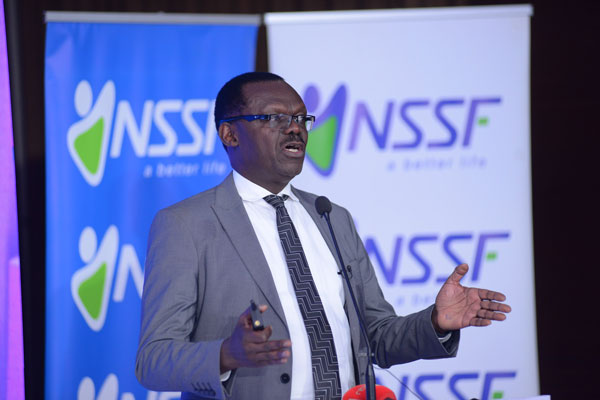
Kampala, Uganda | THE INDEPENDENT | Families of some depositors conniving to prematurely access survivor’s benefits is a significant obstacle to the timely payment of the benefits, the National Social Security Fund (NSSF) has revealed. Survivor’s benefits are a crucial part of NSSF’s benefit payments, intended for the families of deceased members of the fund.
However, there is a growing trend of still-living members’ families prematurely claiming these benefits with the assistance of the depositors. Patrick Ayota, the Managing Director of NSSF, addressed journalists about the fund’s performance for the 2022/23 financial year and expressed concern over the increasing prevalence of this issue. He noted that it is affecting the payment duration of other benefits as additional measures are implemented to verify the information provided.
According to Ayota, four out of ten sampled survivor benefit claims have living savers falsely posing as deceased, which has hindered the fund from achieving its goal of a 12-hour payment target. As a result, the payment duration for benefits has stalled between 12 to 13 days, despite the fund’s initial target of completing payments within 12 hours.
On a positive note, the fund’s performance for the financial year ending on June 30, 2023, showed an increase in revenues, rising from 1.9 trillion shillings to 2.2 trillion shillings. This growth can be attributed to increased earnings from interest income, which increased from 1.79 trillion shillings to 2 trillion shillings, and dividend income, which grew from 84 billion to 139 billion.
Additionally, there was slight growth in real estate income, from 13.4 billion to 14 billion, and 16 billion in other income. Ayota credited this revenue growth to the fund’s strategic asset allocation, which allowed it to remain profitable despite a challenging investment environment in Uganda and the region.
“Overall, the investment environment in Uganda and the region was challenging over the last Financial Year. However, the Fund was able to increase its revenue owing to strategic asset allocation that enabled us to remain profitable, despite a generally depressed market,” he said.
“Although inflation remained under control at 4.8%, the reduction in the value of the stock markets in Uganda and Kenya, the appreciation of the Uganda Shilling against the regional currencies, and the reduction in long-term bond yields increased pressure on the Fund’s performance. For us to post a 15% increase in revenue shows our resilience and an astute investment risk balance,” Ayota added.
The report indicated that long-term bond yields dropped compared to the previous financial year, with reductions observed in the 10-year, 15-year, and 20-year bond yields. Additionally, the stock markets in Uganda, Kenya, Tanzania, and Rwanda experienced a decline in value, impacting NSSF’s major investment destinations. One notable change was the significant appreciation of the Uganda Shilling against major currencies, particularly the Kenya Shilling, which depreciated by 22.2% against the Uganda Shilling.
Despite the fund’s past managerial turbulence, it has maintained a stable financial position, and its Assets Under Management (AUM) continues to grow. “Our Assets Under Management (AUM) increased from Shillings 17.26 trillion in Financial Year 2021/22 to 18.56 trillion in Financial Year 2022/23. This growth was driven by an increase in member contributions, increased realized income, and a cost management strategy that enables us to create more value for the member at a lower cost compared to the previous Financial Year. In fact, with the current asset base, we project that the strategic goal of growing the Assets Under Management of Shillings 20 trillion by 2025 will be achieved by June 30, 2024, one year ahead of schedule,” he explains.
Ayota assured NSSF members that the fund is in a better financial position and emphasized the focus on long-term sustainability, as outlined in their “Vision 2035,” aiming to grow the fund to UGX 50 trillion and achieve a 95% customer satisfaction rate and staff engagement. Benefits paid to qualifying members increased by 1% from 1.189 trillion in the Financial Year 2021/22 to Shillings 1.199 trillion. The cost-to-income ratio improved from 11.7% in the Financial Year 2021/22 to 9.4% in the Financial Year 2022/23, and the rate of compliance slightly improved from 55% to 57%. Additionally, 180,000 new members joined the fund during the year.
*****
URN
 The Independent Uganda: You get the Truth we Pay the Price
The Independent Uganda: You get the Truth we Pay the Price



